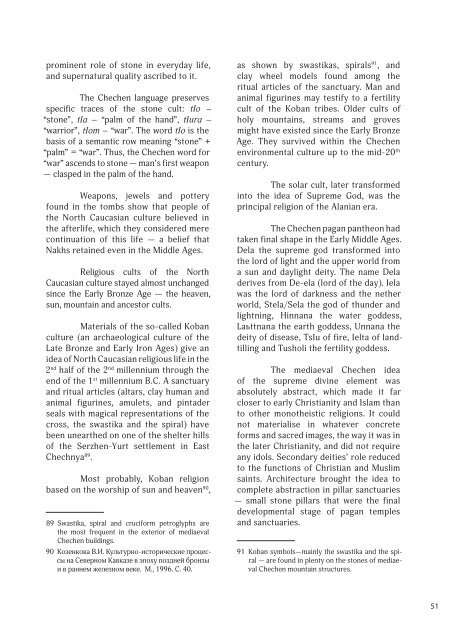The Diversity of the Chechen culture: from ... - unesdoc - Unesco
The Diversity of the Chechen culture: from ... - unesdoc - Unesco
The Diversity of the Chechen culture: from ... - unesdoc - Unesco
Create successful ePaper yourself
Turn your PDF publications into a flip-book with our unique Google optimized e-Paper software.
prominent role <strong>of</strong> stone in everyday life,<br />
and supernatural quality ascribed to it.<br />
<strong>The</strong> <strong>Chechen</strong> language preserves<br />
specific traces <strong>of</strong> <strong>the</strong> stone cult: tIo –<br />
“stone”, tIa – “palm <strong>of</strong> <strong>the</strong> hand”, tIura –<br />
“warrior”, tIom – “war”. <strong>The</strong> word tIo is <strong>the</strong><br />
basis <strong>of</strong> a semantic row meaning “stone” +<br />
“palm” = “war”. Thus, <strong>the</strong> <strong>Chechen</strong> word for<br />
“war” ascends to stone — man’s first weapon<br />
— clasped in <strong>the</strong> palm <strong>of</strong> <strong>the</strong> hand.<br />
Weapons, jewels and pottery<br />
found in <strong>the</strong> tombs show that people <strong>of</strong><br />
<strong>the</strong> North Caucasian <strong>culture</strong> believed in<br />
<strong>the</strong> afterlife, which <strong>the</strong>y considered mere<br />
continuation <strong>of</strong> this life — a belief that<br />
Nakhs retained even in <strong>the</strong> Middle Ages.<br />
Religious cults <strong>of</strong> <strong>the</strong> North<br />
Caucasian <strong>culture</strong> stayed almost unchanged<br />
since <strong>the</strong> Early Bronze Age — <strong>the</strong> heaven,<br />
sun, mountain and ancestor cults.<br />
Materials <strong>of</strong> <strong>the</strong> so-called Koban<br />
<strong>culture</strong> (an archaeological <strong>culture</strong> <strong>of</strong> <strong>the</strong><br />
Late Bronze and Early Iron Ages) give an<br />
idea <strong>of</strong> North Caucasian religious life in <strong>the</strong><br />
2 nd half <strong>of</strong> <strong>the</strong> 2 nd millennium through <strong>the</strong><br />
end <strong>of</strong> <strong>the</strong> 1 st millennium B.C. A sanctuary<br />
and ritual articles (altars, clay human and<br />
animal figurines, amulets, and pintader<br />
seals with magical representations <strong>of</strong> <strong>the</strong><br />
cross, <strong>the</strong> swastika and <strong>the</strong> spiral) have<br />
been unear<strong>the</strong>d on one <strong>of</strong> <strong>the</strong> shelter hills<br />
<strong>of</strong> <strong>the</strong> Serzhen-Yurt settlement in East<br />
Chechnya 89 .<br />
Most probably, Koban religion<br />
based on <strong>the</strong> worship <strong>of</strong> sun and heaven 90 ,<br />
89 Swastika, spiral and cruciform petroglyphs are<br />
<strong>the</strong> most frequent in <strong>the</strong> exterior <strong>of</strong> mediaeval<br />
<strong>Chechen</strong> buildings.<br />
90 Козенкова В.И. Культурно-исторические процессы<br />
на Северном Кавказе в эпоху поздней бронзы<br />
и в раннем железном веке. М., 1996. С. 40.<br />
as shown by swastikas, spirals 91 , and<br />
clay wheel models found among <strong>the</strong><br />
ritual articles <strong>of</strong> <strong>the</strong> sanctuary. Man and<br />
animal figurines may testify to a fertility<br />
cult <strong>of</strong> <strong>the</strong> Koban tribes. Older cults <strong>of</strong><br />
holy mountains, streams and groves<br />
might have existed since <strong>the</strong> Early Bronze<br />
Age. <strong>The</strong>y survived within <strong>the</strong> <strong>Chechen</strong><br />
environmental <strong>culture</strong> up to <strong>the</strong> mid-20 th<br />
century.<br />
<strong>The</strong> solar cult, later transformed<br />
into <strong>the</strong> idea <strong>of</strong> Supreme God, was <strong>the</strong><br />
principal religion <strong>of</strong> <strong>the</strong> Alanian era.<br />
<strong>The</strong> <strong>Chechen</strong> pagan pan<strong>the</strong>on had<br />
taken final shape in <strong>the</strong> Early Middle Ages.<br />
Dela <strong>the</strong> supreme god transformed into<br />
<strong>the</strong> lord <strong>of</strong> light and <strong>the</strong> upper world <strong>from</strong><br />
a sun and daylight deity. <strong>The</strong> name Dela<br />
derives <strong>from</strong> De-ela (lord <strong>of</strong> <strong>the</strong> day). Iela<br />
was <strong>the</strong> lord <strong>of</strong> darkness and <strong>the</strong> ne<strong>the</strong>r<br />
world, Stela/Sela <strong>the</strong> god <strong>of</strong> thunder and<br />
lightning, Hinnana <strong>the</strong> water goddess,<br />
Laьttnana <strong>the</strong> earth goddess, Unnana <strong>the</strong><br />
deity <strong>of</strong> disease, TsIu <strong>of</strong> fire, Ielta <strong>of</strong> landtilling<br />
and Tusholi <strong>the</strong> fertility goddess.<br />
<strong>The</strong> mediaeval <strong>Chechen</strong> idea<br />
<strong>of</strong> <strong>the</strong> supreme divine element was<br />
absolutely abstract, which made it far<br />
closer to early Christianity and Islam than<br />
to o<strong>the</strong>r mono<strong>the</strong>istic religions. It could<br />
not materialise in whatever concrete<br />
forms and sacred images, <strong>the</strong> way it was in<br />
<strong>the</strong> later Christianity, and did not require<br />
any idols. Secondary deities’ role reduced<br />
to <strong>the</strong> functions <strong>of</strong> Christian and Muslim<br />
saints. Architecture brought <strong>the</strong> idea to<br />
complete abstraction in pillar sanctuaries<br />
— small stone pillars that were <strong>the</strong> final<br />
developmental stage <strong>of</strong> pagan temples<br />
and sanctuaries.<br />
91 Koban symbols—mainly <strong>the</strong> swastika and <strong>the</strong> spiral<br />
— are found in plenty on <strong>the</strong> stones <strong>of</strong> mediaeval<br />
<strong>Chechen</strong> mountain structures.<br />
51

















